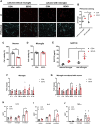The SAP130/Mincle axis was involved in sevoflurane-induced neuronal death and microglial activation in juvenile mice
- PMID: 40792209
- PMCID: PMC12336192
- DOI: 10.3389/fphar.2025.1647329
The SAP130/Mincle axis was involved in sevoflurane-induced neuronal death and microglial activation in juvenile mice
Abstract
Introduction: Sevoflurane is widely used in pediatric anesthesia and has raised concerns for years regarding its neurotoxic effects on the developing brain. Studies have shown that sevoflurane can lead to neuronal cell death and neuroinflammation, which further contribute to sevoflurane-induced neurotoxicity manifested as delirium or cognitive deficits. However, the molecular mechanism remains poorly understood. A factor of interest is Sin3A-associated protein 130 (SAP130), which can be released by dead or damaged cells and trigger sterile inflammation, exacerbating tissue damage by activating the macrophage-inducible C-type lectin (Mincle) receptor. However, whether the SAP130/Mincle axis is involved in sevoflurane-induced neurotoxicity remains unknown.
Methods: Using a young murine sevoflurane exposure model and a primary neuron-microglia co-culture system, we examined changes in neuronal cell death, microglial activation, cytokine production, and the expression levels of SAP130- and Mincle-signaling-associated proteins after sevoflurane exposure. We then applied SAP130-neutralizing antibody and the Syk inhibitor piceatannol to assess the impact of inhibiting the Mincle pathway on microglial activation and sevoflurane-induced neurotoxicity.
Results: The results demonstrated that sevoflurane exposure increased the number of dead neurons with SAP130 upregulation and induced microglial activation with cytokine production in the hippocampus. These changes occurred only in the neuron-microglia co-culture system but not in neuron or microglia monoculture. Neutralizing SAP130 or pharmacologically inhibiting syk diminished microglial activation and neuronal cell death by suppressing the SAP130/Mincle signaling pathway.
Discussion: These findings suggest that the SAP130/Mincle axis plays a crucial role in neuronal death and microglial activation in sevoflurane-induced neurotoxicity. Targeting this axis emerges as a potential therapeutic strategy to mitigate the neurotoxic effects of sevoflurane.
Keywords: Mincle; SAP130; microglia; neuroinflammation; neuron; sevoflurane.
Copyright © 2025 Zhou, Chen, Zhang, Shu and Chen.
Conflict of interest statement
The authors declare that the research was conducted in the absence of any commercial or financial relationships that could be construed as a potential conflict of interest. The reviewer JL declared a shared affiliation with the authors to the handling editor at the time of review.
Figures






Similar articles
-
Sesamin attenuates liver inflammation caused by PFOS via regulating SAP130-mediated hepatocyte-macrophage crosstalk.Ecotoxicol Environ Saf. 2025 Aug 6;303:118773. doi: 10.1016/j.ecoenv.2025.118773. Online ahead of print. Ecotoxicol Environ Saf. 2025. PMID: 40773918
-
Short-Term Memory Impairment.2024 Jun 8. In: StatPearls [Internet]. Treasure Island (FL): StatPearls Publishing; 2025 Jan–. 2024 Jun 8. In: StatPearls [Internet]. Treasure Island (FL): StatPearls Publishing; 2025 Jan–. PMID: 31424720 Free Books & Documents.
-
Microglia either promote or restrain TRAIL-mediated excitotoxicity caused by Aβ1-42 oligomers.J Neuroinflammation. 2024 Sep 1;21(1):215. doi: 10.1186/s12974-024-03208-2. J Neuroinflammation. 2024. PMID: 39218898 Free PMC article.
-
Effects of sevoflurane versus other general anaesthesia on emergence agitation in children.Cochrane Database Syst Rev. 2014 Sep 12;2014(9):CD007084. doi: 10.1002/14651858.CD007084.pub2. Cochrane Database Syst Rev. 2014. PMID: 25212274 Free PMC article.
-
Management of urinary stones by experts in stone disease (ESD 2025).Arch Ital Urol Androl. 2025 Jun 30;97(2):14085. doi: 10.4081/aiua.2025.14085. Epub 2025 Jun 30. Arch Ital Urol Androl. 2025. PMID: 40583613 Review.
References
LinkOut - more resources
Full Text Sources
Miscellaneous

